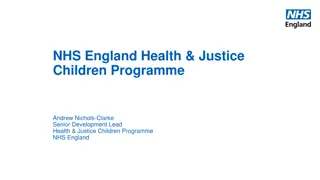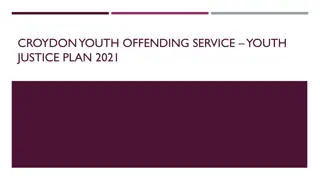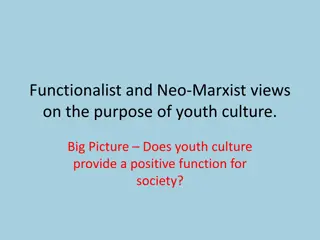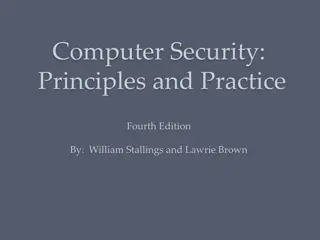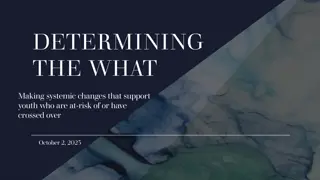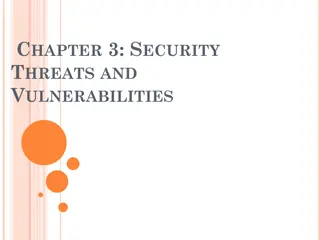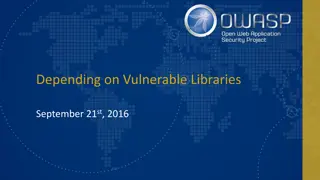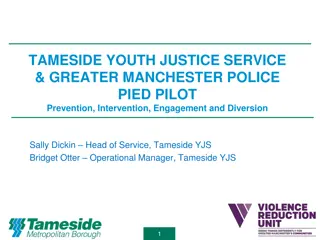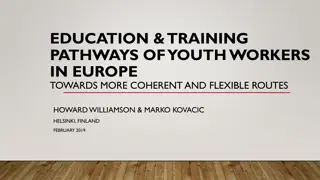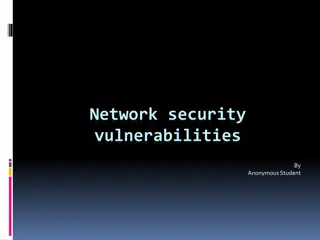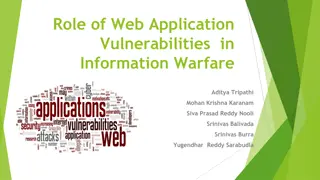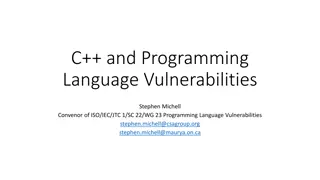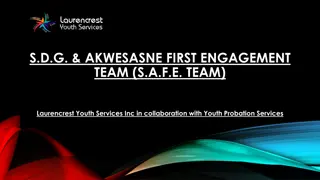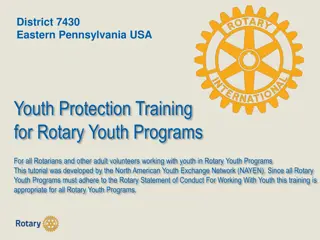Youth Justice: Understanding Risks and Vulnerabilities
The study of youth transitions and crime in Edinburgh sheds light on issues such as graffiti, stealing, underage drinking, trauma, abuse, and violent behavior among young individuals. Factors like weak bonds, personality traits, bullying, family dynamics, and social deprivation contribute to youth offending. Children under 12 involved in offenses often have parents at risk, mental health difficulties, and abuse histories. Victims of harm by other children are predominantly fellow youngsters. Strategies are needed to address these complex challenges in youth justice.
Download Presentation

Please find below an Image/Link to download the presentation.
The content on the website is provided AS IS for your information and personal use only. It may not be sold, licensed, or shared on other websites without obtaining consent from the author.If you encounter any issues during the download, it is possible that the publisher has removed the file from their server.
You are allowed to download the files provided on this website for personal or commercial use, subject to the condition that they are used lawfully. All files are the property of their respective owners.
The content on the website is provided AS IS for your information and personal use only. It may not be sold, licensed, or shared on other websites without obtaining consent from the author.
E N D
Presentation Transcript
95% Graffiti Graffiti, stealing money from home, , stealing money from home, underage drinking underage drinking etc.. Edinburgh Study of Youth Transitions and Crime etc.. www.cycj.org.uk developing, supporting & understanding youth justice
5% children 24,000 children 6% of crimes & offences Scottish Government (2013) Scottish Policing Performance Framework, 2012-13 www.cycj.org.uk developing, supporting & understanding youth justice
Trauma, bereavement, loss and Trauma, bereavement, loss and abuse abuse www.cycj.org.uk developing, supporting & understanding youth justice
V Violent offenders were iolent offenders were significantly more likely than non more likely than non- -violent youths to be youths to be victims of crime and adult harassment self-harming and para-suicidal behaviour problematic health risk behaviours Weak bonds (parent / school) Personality measures (impulsivity and risk taking) Bullying others Family turbulence socially deprivation Friends involved in offending (McAra & McVie, 2010) significantly violent www.cycj.org.uk developing, supporting & understanding youth justice
100 children under 12 100 children under 12 referred on offence grounds referred on offence grounds For those children whose offence referral was part of a pattern of behaviour: 81% of these children had parents who presented risks to them 43% had mental health difficulties 70% educational problems 30% had been the victims of physical or sexual abuse. (Henderson et al, 2016)
Children most likely to harm Children most likely to harm other children other children Where victims were identified 67 instances. 81% victims were children (Henderson et al, 2016)
IVY IVY - - background background Over 80% input from social work services and looked after status 76% exposed to domestic violence 88% experienced some other form of maltreatment Mean of 4 psychological/mental disorders www.cycj.org.uk developing, supporting & understanding youth justice
Boys - 34% 6 or more ACE Girls 50% 6 or more ACE (Johnson, 2016)
Bereavement Bereavement & loss in Polmont Polmont YOI & loss in YOI Over three-quarters experienced traumatic bereavements (murder, suicide etc) Two-thirds suffering from substantial bereavements (four or more) (Vaswani, 2014) www.cycj.org.uk developing, supporting & understanding youth justice
Speech, language & Speech, language & communication needs communication needs 50-60% children involved in youth justice services (UK wide) See: A guide to Youth Justice in Scotland, http://www.cycj.org.uk/resource/youth- justice-in-scotland-guide www.cycj.org.uk developing, supporting & understanding youth justice
School Exclusion School Exclusion 80% of the young men in Polmont had experienced exclusion from school High levels of school exclusions at primary school age CYCJ (2014) Young Men in Custody, http://www.cycj.org.uk/resource/young-men-in-custody-a- report-on-the-pathways-into-and-out-of-prison-of-young- men-aged-16-and-17/ www.cycj.org.uk developing, supporting & understanding youth justice
Retrospective NOT predictive Retrospective NOT predictive Serious offending Serious offending Children who Children who experience experience trauma trauma DO NOT OFFEND DO NOT OFFEND Children who Children who seriously seriously offend offend EXPERIENCED EXPERIENCED TRAUMA TRAUMA No experience of trauma
References References CYCJ (2014) Young Men in Custody, http://www.cycj.org.uk/resource/young-men-in-custody-a-report- on-the-pathways-into-and-out-of-prison-of-young-men-aged-16-and-17/ CYCJ (2015) A Guide to Youth Justice in Scotland, http://www.cycj.org.uk/resource/youth-justice-in- scotland-guide/ Henderson, G. et al. (2016) Backgrounds and outcomes for children aged 8 to 11 years old who have been referred to the Children s Reporter for offending, http://www.scra.gov.uk/wp- content/uploads/2016/03/Backgrounds-and-outcomes-for-children-aged-8-11-years-old-who-have- been-referred-for-offending.pdf Johnson, D. (2016) How does trauma affect young people?, https://prezi.com/9h6tpxzbl8qv/new-5- how-does-trauma-affect-young-people/ McAra, L. and McVie, S. (2010) Youth crime and Justice: Key Messages from the Edinburgh Study of Youth Transitions and Crime, www.research.ed.ac.uk/portal/files/8195355/Youth_crime_and_justice_Key_messages_from_the_Edin burgh_Study_of_Youth_Transitions_and_Crime_Criminology_and_Criminal_Justice.pdf Mental Health Difficulties in the Youth Justice Population: Learning from the first six months of the IVY project, www.cycj.org.uk/wp-content/uploads/2014/07/Briefing-Paper-5-final.pdf Scottish Government (2013) Scottish Policing Performance Framework, 2012-13. Vaswani, N. (2014) The Ripples of Death: Exploring the Bereavement Experiences and Mental Health of Young Men in Custody, http://onlinelibrary.wiley.com/doi/10.1111/hojo.12064/full www.cycj.org.uk developing, supporting & understanding youth justice





